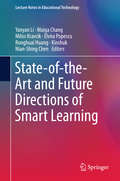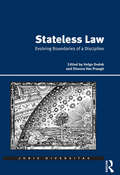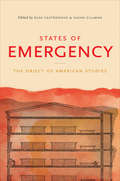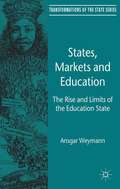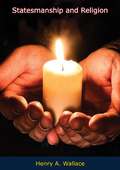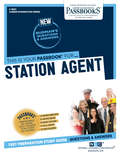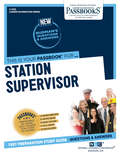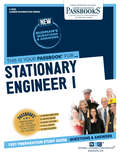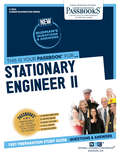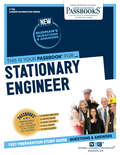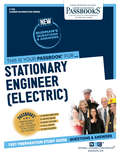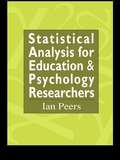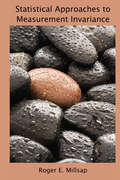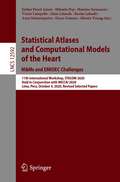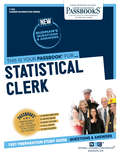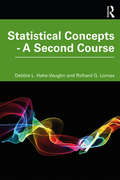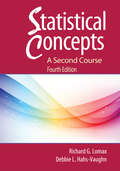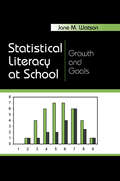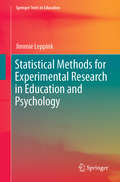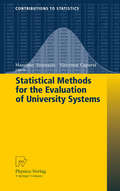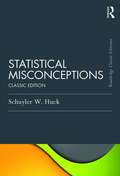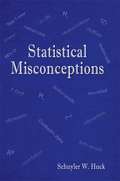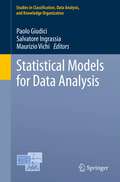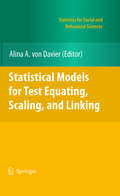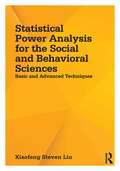- Table View
- List View
State-of-the-Art and Future Directions of Smart Learning
by Kinshuk Yanyan Li Ronghuai Huang Maiga Chang Nian-Shing Chen Milos Kravcik Elvira PopescuThis book provides an archival forum for researchers, academics, practitioners and industry professionals interested and/or engaged in reforming teaching and learning methods by transforming today's learning environments into smart learning environments. It will facilitate opportunities for discussions and constructive dialogue between various stakeholders on the limitations of current learning environments, the need for reform, innovative uses of emerging pedagogical approaches and technologies, and sharing and promoting best practices, which will lead to the evolution, design and implementation of smart learning environments. The focus of the contributions is on the interplay and fusion of pedagogy and technology to create these new environments. The components of this interplay include but are not limited to: Pedagogy: learning paradigms, assessment paradigms, social factors, policy Technology: emerging technologies, innovative uses of mature technologies, adoption, usability, standards, and emerging/new technological paradigms (open educational resources, cloud computing, etc. ) Fusion of pedagogy and technology: transformation of curricula, transformation of teaching behavior, transformation of administration, best practices of infusion, piloting of new ideas.
Stateless Law: Evolving Boundaries of a Discipline (Juris Diversitas)
by Shauna Van Praagh Helge DedekThis volume offers a critical analysis and illustration of the challenges and promises of ’stateless’ law thought, pedagogy and approaches to governance - that is, understanding and conceptualizing law in a post-national condition. From common, civil and international law perspectives, the collection focuses on the definition and role of law as an academic discipline, and hybridity in the practice and production of law. With contributions by a diverse and international group of scholars, the collection includes fourteen chapters written in English and three in French. Confronting the ’transnational challenge’ posed to the traditional theoretical and institutional structures that underlie the teaching and study of law in the university, the seventeen authors of Stateless Law: Evolving Boundaries of a Discipline bring new insight to the ongoing and crucial conversation about the future shape of legal scholarship, education and practice that is emblematic of the early twenty-first century. This collection is essential reading for academics, institutions and others involved in determining the future roles, responsibilities and education of jurists, as well as for academics interested in Law, Sociology, Political Science and Education.
States of Emergency: The Object of American Studies
by Russ CastronovoThe contributors to this volume argue that for too long, inclusiveness has substituted for methodology in American studies scholarship. The ten original essays collected here call for a robust comparativism that is attuned theoretically to questions of both space and time. States of Emergencyasks readers to engage in a thought experiment: imagine that you have an object you want to study. Which methodologies will contextualize and explain your selection? What political goals are embedded in your inquiry? This thought experiment is taken up by contributors who consider an array of objects--the weather, cigarettes, archival material, AIDS, the enemy, extinct species, and torture. The essayists recalibrate the metrics of time and space usually used to measure these questions. In the process, each contributes to a project that redefines the object of American studies, reading its history as well as its future across, against, even outside the established grain of interdisciplinary practice. Contributors: Srinivas Aravamudan, Duke University Ian Baucom, Duke University Chris Castiglia, The Pennsylvania State University Russ Castronovo, University of Wisconsin-Madison Wai Chee Dimock, Yale University Nan Enstad, University of Wisconsin-Madison Susan Gillman, University of California, Santa Cruz Rodrigo Lazo, University of California, Irvine Robert S. Levine, University of Maryland Anne McClintock, University of Wisconsin-Madison Kenneth W. Warren, University of Chicago
States, Markets and Education
by Ansgar WeymannEducation policy is a core element of the state's sovereignty and autonomy. This book analyzes the rise of the western education state and its limits in times of transition from western to non-western globalization and of waning newspaper interest in France, Germany, the UK and the US.
Statesmanship and Religion
by Henry A. WallaceHenry Agard Wallace, served as 11th Secretary of Agriculture (1933-1940), during the tumultuous time of the New Deal as the America recovered from the Great Depression. In this book discusses the ethical basis of the New Deal and its relationship to other reform movements.
Station Agent: Passbooks Study Guide (Career Examination Series #Vol. C-3807)
by National Learning CorporationThe Station Agent Passbook® prepares you for your test by allowing you to take practice exams in the subjects you need to study. It provides hundreds of questions and answers in the areas that will likely be covered on your upcoming exam, including but not limited to: resolving customers' concerns, problems or complaints; interpreting timetables, subway maps and other printed material; understanding subway operating procedures; following procedures in the event of emergencies or unusual occurrences; job-related arithmetic; points of interest in the city; and more.
Station Supervisor: Passbooks Study Guide (Career Examination Series)
by National Learning CorporationThe Station Supervisor Passbook® prepares you for your test by allowing you to take practice exams in the subjects you need to study. It provides hundreds of questions and answers in the areas that will likely be covered on your upcoming exam.
Stationary Engineer I: Passbooks Study Guide (Career Examination Series #C-1603)
by National Learning CorporationThe Stationary Engineer I Passbook® prepares you for your test by allowing you to take practice exams in the subjects you need to study. It provides hundreds of questions and answers in the areas that will likely be covered on your upcoming exam.
Stationary Engineer II: Passbooks Study Guide (Career Examination Series)
by National Learning CorporationThe Stationary Engineer II Passbook® prepares you for your test by allowing you to take practice exams in the subjects you need to study. It provides hundreds of questions and answers in the areas that will likely be covered on your upcoming exam.
Stationary Engineer: Passbooks Study Guide (Career Examination Series #C-1603)
by National Learning CorporationThe Stationary Engineer Passbook® prepares you for your test by allowing you to take practice exams in the subjects you need to study. It provides hundreds of questions and answers in the areas that will likely be covered on your upcoming exam.
Stationary Engineer: Passbooks Study Guide (Career Examination Series #C-1603)
by National Learning CorporationThe Stationary Engineer (Electric) Passbook® prepares you for your test by allowing you to take practice exams in the subjects you need to study. It provides hundreds of questions and answers in the areas that will likely be covered on your upcoming exam, including but not limited to: fundamentals of electronics, circuits and machinery; safety principles; motors, engines and HVAC equipment and systems; computer operations; record keeping; supervision; and more.
Statistical Analysis for Education and Psychology Researchers: Tools for researchers in education and psychology
by Ian PeersBasic statistical concepts such as probability, estimation and inference, and their role in research design and analysis are presented in this volume. The author demonstrates which statistical test to use in given circumstances and how to use it, drawing on data from psychology and education.; Written for those without a strong mathematical background, the book's examples can be worked using a pocket calculator. "Real life" data are analyzed using statistical software (SAS), output is interpreted, and a decision chart is presented which summarizes considerations when choosing a statistical test.
Statistical Approaches to Measurement Invariance
by Roger E. MillsapThis book reviews the statistical procedures used to detect measurement bias. Measurement bias is examined from a general latent variable perspective so as to accommodate different forms of testing in a variety of contexts including cognitive or clinical variables, attitudes, personality dimensions, or emotional states. Measurement models that underlie psychometric practice are described, including their strengths and limitations. Practical strategies and examples for dealing with bias detection are provided throughout. The book begins with an introduction to the general topic, followed by a review of the measurement models used in psychometric theory. Emphasis is placed on latent variable models, with introductions to classical test theory, factor analysis, and item response theory, and the controversies associated with each, being provided. Measurement invariance and bias in the context of multiple populations is defined in chapter 3 followed by chapter 4 that describes the common factor model for continuous measures in multiple populations and its use in the investigation of factorial invariance. Identification problems in confirmatory factor analysis are examined along with estimation and fit evaluation and an example using WAIS-R data. The factor analysis model for discrete measures in multiple populations with an emphasis on the specification, identification, estimation, and fit evaluation issues is addressed in the next chapter. An MMPI item data example is provided. Chapter 6 reviews both dichotomous and polytomous item response scales emphasizing estimation methods and model fit evaluation. The use of models in item response theory in evaluating invariance across multiple populations is then described, including an example that uses data from a large-scale achievement test. Chapter 8 examines item bias evaluation methods that use observed scores to match individuals and provides an example that applies item response theory to data introduced earlier in the book. The book concludes with the implications of measurement bias for the use of tests in prediction in educational or employment settings. A valuable supplement for advanced courses on psychometrics, testing, measurement, assessment, latent variable modeling, and/or quantitative methods taught in departments of psychology and education, researchers faced with considering bias in measurement will also value this book.
Statistical Atlases and Computational Models of the Heart. M&Ms and EMIDEC Challenges: 11th International Workshop, STACOM 2020, Held in Conjunction with MICCAI 2020, Lima, Peru, October 4, 2020, Revised Selected Papers (Lecture Notes in Computer Science #12592)
by Oscar Camara Mihaela Pop Maxime Sermesant Alistair Young Alain Lalande Avan Suinesiaputra Esther Puyol Anton Victor Campello Karim LekadirThis book constitutes the proceedings of the 11th International Workshop on Statistical Atlases and Computational Models of the Heart, STACOM 2020, as well as two challenges: M&Ms - The Multi-Centre, Multi-Vendor, Multi-Disease Segmentation Challenge, and EMIDEC - Automatic Evaluation of Myocardial Infarction from Delayed-Enhancement Cardiac MRI Challenge. The 43 full papers included in this volume were carefully reviewed and selected from 70 submissions. They deal with cardiac imaging and image processing, machine learning applied to cardiac imaging and image analysis, atlas construction, artificial intelligence, statistical modelling of cardiac function across different patient populations, cardiac computational physiology, model customization, atlas based functional analysis, ontological schemata for data and results, integrated functional and structural analyses, as well as the pre-clinical and clinical applicability of these methods.
Statistical Clerk: Passbooks Study Guide (Career Examination Series)
by National Learning CorporationThe Statistical Clerk Passbook® prepares you for your test by allowing you to take practice exams in the subjects you need to study. It provides hundreds of questions and answers in the areas that will likely be covered on your upcoming exam, including but not limited to: Clerical responsibilities and abilities; Data collection, compilation and processing; Arithmetic computation/reasoning; Chart and table interpretation; Data coding, reviewing and editing; and more.
Statistical Concepts - A Second Course
by Richard G. Lomax Debbie L. Hahs-VaughnStatistical Concepts—A Second Course presents the last 10 chapters from An Introduction to Statistical Concepts, Fourth Edition. Designed for second and upper-level statistics courses, this book highlights how statistics work and how best to utilize them to aid students in the analysis of their own data and the interpretation of research results. In this new edition, Hahs-Vaughn and Lomax discuss sensitivity, specificity, false positive and false negative errors. Coverage of effect sizes has been expanded upon and more organizational features (to summarize key concepts) have been included. A final chapter on mediation and moderation has been added for a more complete presentation of regression models. This book acts as a clear and accessible instructional tool to help readers fully understand statistical concepts and how to apply them to data. It is an invaluable resource for students undertaking a course in statistics in any number of social science and behavioral science disciplines.
Statistical Concepts: A Second Course
by Debbie L. Hahs-Vaughn Richard G. LomaxStatistical Concepts consists of the last 9 chapters of An Introduction to Statistical Concepts, 3rd ed. Designed for the second course in statistics, it is one of the few texts that focuses just on intermediate statistics. The book highlights how statistics work and what they mean to better prepare students to analyze their own data and interpret SPSS and research results. As such it offers more coverage of non-parametric procedures used when standard assumptions are violated since these methods are more frequently encountered when working with real data. Determining appropriate sample sizes is emphasized throughout. Only crucial equations are included. The new edition features: New co-author, Debbie L. Hahs-Vaughn, the 2007 recipient of the University of Central Florida's College of Education Excellence in Graduate Teaching Award. A new chapter on logistic regression models for today's more complex methodologies. Much more on computing confidence intervals and conducting power analyses using G*Power. All new SPSS version 19 screenshots to help navigate through the program and annotated output to assist in the interpretation of results. Sections on how to write-up statistical results in APA format and new templates for writing research questions. New learning tools including chapter-opening vignettes, outlines, a list of key concepts, "Stop and Think" boxes, and many more examples, tables, and figures. More tables of assumptions and the effects of their violation including how to test them in SPSS. 33% new conceptual, computational, and all new interpretative problems. A website with Power Points, answers to the even-numbered problems, detailed solutions to the odd-numbered problems, and test items for instructors, and for students the chapter outlines, key concepts, and datasets. Each chapter begins with an outline, a list of key concepts, and a research vignette related to the concepts. Realistic examples from education and the behavioral sciences illustrate those concepts. Each example examines the procedures and assumptions and provides tips for how to run SPSS and develop an APA style write-up. Tables of assumptions and the effects of their violation are included, along with how to test assumptions in SPSS. Each chapter includes computational, conceptual, and interpretive problems. Answers to the odd-numbered problems are provided. The SPSS data sets that correspond to the book’s examples and problems are available on the web.? The book covers basic and advanced analysis of variance models and topics not dealt with in other texts such as robust methods, multiple comparison and non-parametric procedures, and multiple and logistic regression models. Intended for courses in intermediate statistics and/or statistics II taught in education and/or the behavioral sciences, predominantly at the master's or doctoral level. Knowledge of introductory statistics is assumed.
Statistical Literacy at School: Growth and Goals (Studies in Mathematical Thinking and Learning Series)
by Jane M. WatsonThis book reveals the development of students' understanding of statistical literacy. It provides a way to "see" student thinking and gives readers a deeper sense of how students think about important statistical topics. Intended as a complement to curriculum documents and textbook series, it is consistent with the current principles and standards of the National Council of Teachers of Mathematics. The term "statistical literacy" is used to emphasize that the purpose of the school curriculum should not be to turn out statisticians but to prepare statistically literate school graduates who are prepared to participate in social decision making. Based on ten years of research--with reference to other significant research as appropriate--the book looks at students' thinking in relation to tasks based on sampling, graphical representations, averages, chance, beginning inference, and variation, which are essential to later work in formal statistics. For those students who do not proceed to formal study, as well as those who do, these concepts provide a basis for decision making or questioning when presented with claims based on data in societal settings. Statistical Literacy at School: Growth and Goals:*establishes an overall framework for statistical literacy in terms of both the links to specific school curricula and the wider appreciation of contexts within which chance and data-handling ideas are applied;*demonstrates, within this framework, that there are many connections among specific ideas and constructs;*provides tasks, adaptable for classroom or assessment use, that are appropriate for the goals of statistical literacy; *presents extensive examples of student performance on the tasks, illustrating hierarchies of achievement, to assist in monitoring gains and meeting the goals of statistical literacy; and*includes a summary of analysis of survey data that suggests a developmental hierarchy for students over the years of schooling with respect to the goal of statistical literacy.Statistical Literacy at School: Growth and Goals is directed to researchers, curriculum developers, professionals, and students in mathematics education as well those across the curriculum who are interested in students' cognitive development within the field; to teachers who want to focus on the concepts involved in statistical literacy without the use of formal statistical techniques; and to statisticians who are interested in the development of student understanding before students are exposed to the formal study of statistics.
Statistical Methods for Experimental Research in Education and Psychology (Springer Texts in Education)
by Jimmie LeppinkThis book focuses on experimental research in two disciplines that have a lot of common ground in terms of theory, experimental designs used, and methods for the analysis of experimental research data: education and psychology. Although the methods covered in this book are also frequently used in many other disciplines, including sociology and medicine, the examples in this book come from contemporary research topics in education and psychology. Various statistical packages, commercial and zero-cost Open Source ones, are used.The goal of this book is neither to cover all possible statistical methods out there nor to focus on a particular statistical software package. There are many excellent statistics textbooks on the market that present both basic and advanced concepts at an introductory level and/or provide a very detailed overview of options in a particular statistical software programme. This is not yet another book in that genre. Core theme of this book is a heuristic called the question-design-analysis bridge: there is a bridge connecting research questions and hypotheses, experimental design and sampling procedures, and common statistical methods in that context. Each statistical method is discussed in a concrete context of a set of research question with directed (one-sided) or undirected (two-sided) hypotheses and an experimental setup in line with these questions and hypotheses. Therefore, the titles of the chapters in this book do not include any names of statistical methods such as ‘analysis of variance’ or ‘analysis of covariance’. In a total of seventeen chapters, this book covers a wide range of topics of research questions that call for experimental designs and statistical methods, fairly basic or more advanced.
Statistical Methods for the Evaluation of University Systems
by Vincenza Capursi Massimo AttanasioThis book presents a collection of statistical methods and procedures to assess data coming from educational systems. The topics examined include: statistical methods for constructing composite indicators, applied measurements, assessment of educational systems, measurement of the performance of the students at Italian universities, and statistical modeling for questionnaire data. Other issues are the implications of introducing different assessment criteria and procedures to the Italian university system.
Statistical Misconceptions: Classic Edition (Psychology Press & Routledge Classic Editions)
by Schuyler W. HuckThis engaging book helps readers identify and then discard 52 misconceptions about data and statistical summaries. The focus is on major concepts contained in typical undergraduate and graduate courses in statistics, research methods, or quantitative analysis. Interactive Internet exercises that further promote undoing the misconceptions are found on the book's website. The author’s accessible discussion of each misconception has five parts: The Misconception - a brief description of the misunderstanding Evidence that the Misconception Exists – examples and claimed prevalence Why the Misconception is Dangerous – consequence of having the misunderstanding Undoing the Misconception - how to think correctly about the concept Internet Assignment - an interactive activity to help readers gain a firm grasp of the statistical concept and overcome the misconception. The book's statistical misconceptions are grouped into 12 chapters that match the topics typically taught in introductory/intermediate courses. However, each of the 52 discussions is self-contained, thus allowing the misconceptions to be covered in any order without confusing the reader. Organized and presented in this manner, the book is an ideal supplement for any standard textbook. An ideal supplement for undergraduate and graduate courses in statistics, research methods, or quantitative analysis taught in psychology, education, business, nursing, medicine, and the social sciences. The book also appeals to independent researchers interested in undoing their statistical misconceptions.
Statistical Misconceptions: Classic Edition (Psychology Press And Routledge Classic Editions Ser.)
by Schuyler HuckBrief and inexpensive, this engaging book helps readers identify and then discard 52 misconceptions about data and statistical summaries. The focus is on major concepts contained in typical undergraduate and graduate courses in statistics, research methods, or quantitative analysis. Fun interactive Internet exercises that further promote undoing the misconceptions are found on the book's website. The author’s accessible discussion of each misconception has five parts: The Misconception - a brief description of the misunderstanding Evidence that the Misconception Exists – examples and claimed prevalence Why the Misconception is Dangerous – consequence of having the misunderstanding Undoing the Misconception - how to think correctly about the concept Internet Assignment - an interactive activity to help readers gain a firm grasp of the statistical concept and overcome the misconception. The book's statistical misconceptions are grouped into 12 chapters that match the topics typically taught in introductory/intermediate courses. However, each of the 52 discussions is self-contained, thus allowing the misconceptions to be covered in any order without confusing the reader. Organized and presented in this manner, the book is an ideal supplement for any standard textbook. Statistical Misconceptions is appropriate for courses taught in a variety of disciplines including psychology, medicine, education, nursing, business, and the social sciences. The book also will benefit independent researchers interested in undoing their statistical misconceptions.
Statistical Models for Data Analysis
by Paolo Giudici Maurizio Vichi Salvatore IngrassiaThe papers in this book cover issues related to the development of novel statistical models for the analysis of data. They offer solutions for relevant problems in statistical data analysis and contain the explicit derivation of the proposed models as well as their implementation. The book assembles the selected and refereed proceedings of the biannual conference of the Italian Classification and Data Analysis Group (CLADAG), a section of the Italian Statistical Society.
Statistical Models for Test Equating, Scaling, and Linking
by Alina A. DavierThe goal of this book is to emphasize the formal statistical features of the practice of equating, linking, and scaling. The book encourages the view and discusses the quality of the equating results from the statistical perspective (new models, robustness, fit, testing hypotheses, statistical monitoring) as opposed to placing the focus on the policy and the implications, which although very important, represent a different side of the equating practice. The book contributes to establishing "equating" as a theoretical field, a view that has not been offered often before. The tradition in the practice of equating has been to present the knowledge and skills needed as a craft, which implies that only with years of experience under the guidance of a knowledgeable practitioner could one acquire the required skills. This book challenges this view by indicating how a good equating framework, a sound understanding of the assumptions that underlie the psychometric models, and the use of statistical tests and statistical process control tools can help the practitioner navigate the difficult decisions in choosing the final equating function. This book provides a valuable reference for several groups: (a) statisticians and psychometricians interested in the theory behind equating methods, in the use of model-based statistical methods for data smoothing, and in the evaluation of the equating results in applied work; (b) practitioners who need to equate tests, including those with these responsibilities in testing companies, state testing agencies, and school districts; and (c) instructors in psychometric, measurement, and psychology programs.
Statistical Power Analysis for the Social and Behavioral Sciences: Basic and Advanced Techniques
by Xiaofeng Steven LiuThis is the first book to demonstrate the application of power analysis to the newer more advanced statistical techniques that are increasingly used in the social and behavioral sciences. Both basic and advanced designs are covered. Readers are shown how to apply power analysis to techniques such as hierarchical linear modeling, meta-analysis, and structural equation modeling. Each chapter opens with a review of the statistical procedure and then proceeds to derive the power functions. This is followed by examples that demonstrate how to produce power tables and charts. The book clearly shows how to calculate power by providing open code for every design and procedure in R, SAS, and SPSS. Readers can verify the power computation using the computer programs on the book's website. There is a growing requirement to include power analysis to justify sample sizes in grant proposals. Most chapters are self-standing and can be read in any order without much disruption.This book will help readers do just that. Sample computer code in R, SPSS, and SAS at www.routledge.com/9781848729810 are written to tabulate power values and produce power curves that can be included in a grant proposal. Organized according to various techniques, chapters 1 – 3 introduce the basics of statistical power and sample size issues including the historical origin, hypothesis testing, and the use of statistical power in t tests and confidence intervals. Chapters 4 - 6 cover common statistical procedures -- analysis of variance, linear regression (both simple regression and multiple regression), correlation, analysis of covariance, and multivariate analysis. Chapters 7 - 11 review the new statistical procedures -- multi-level models, meta-analysis, structural equation models, and longitudinal studies. The appendixes contain a tutorial about R and show the statistical theory of power analysis. Intended as a supplement for graduate courses on quantitative methods, multivariate statistics, hierarchical linear modeling (HLM) and/or multilevel modeling and SEM taught in psychology, education, human development, nursing, and social and life sciences, this is the first text on statistical power for advanced procedures. Researchers and practitioners in these fields also appreciate the book‘s unique coverage of the use of statistical power analysis to determine sample size in planning a study. A prerequisite of basic through multivariate statistics is assumed.
